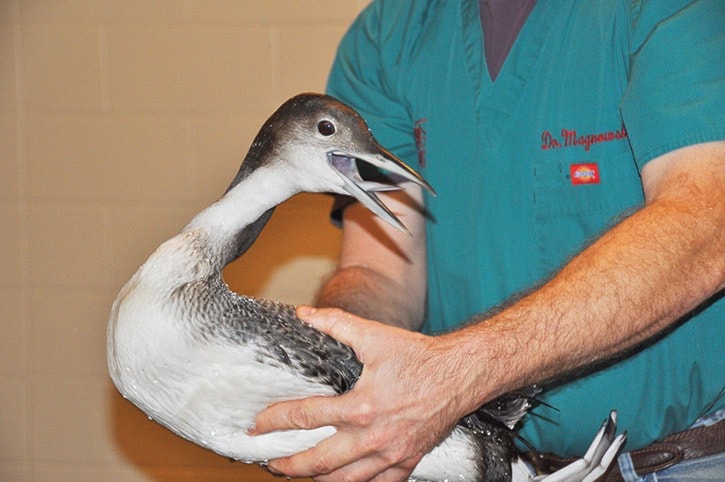A young loon, rescued from a small patch of open water on Horsefly Lake, was sent to Burnaby Wildlife Rescue thanks to good-hearted neighbours.
Horsefly residents, South Cariboo Search and Rescue, Animal Care Hospital and Pacific Coastal Airlines were all involved in the rescue.
Residents at Horsefly Lake noticed two immature loons trapped in a small open water area and decided to get help.
South Cariboo Search and Rescue team leader James Seeley explained that he got a phone call from his daughter, Becky Cadsand, from the Horsefly Lake area, saying that she had heard about two loons trapped by encroaching ice.
Dr. Doug Magnowski at Animal Care Hospital, who took in the bird and arranged its flight to Vancouver, said that reduced open water is a real risk to loons.
“A loon requires a long length of water to take off flying and the small piece of open water in Horsefly Lake basically had the two birds trapped. Everybody migrated and he got left behind,” he explained.
“Loons are amazing swimmers and divers but cannot walk on land; they can’t sit against a hard surface because it blocks blood flow from the ‘keel’, or main flying muscle - they can’t be out of water for long. We could have sent him by truck, but it would have been too long out of water and he likely wouldn’t have survived.”
Seeley said that when he couldn’t reach Central Cariboo Search and Rescue, he contacted his team members Randy McRoberts and Peter Crawshay, packed up ice rescue gear and equipment and headed to Horsefly Lake.
Becky said that the ice rescue volunteers arrived with kayaks and dry suits and that Fisheries loaned them dip nets to help with the project.
She also said that a bald eagle had been harassing the loons for several hours before the rescue.
“The ice was very thin and it was sketchy getting out there. The birds were panicking, swimming underwater and only popping up to breathe. We used salmon nets and were able to catch one of the birds. We wrapped it in a soft wool blanket and put it in a pet carrier,” Seeley explained.
“The other bird disappeared under the ice and we couldn’t find it. There is a chance that it might have made it to a larger patch of open water some distance away. We know that these birds would have perished without our interference and are so glad we were able to rescue one of them.”
When the bird arrived at Animal Care Hospital Dr. Magnowski began arranging the bird’s transport to the Burnaby Wildlife Rescue.
He explained that Pacific Coastal Airlines transports injured wildlife for the local animal hospital year round.
“They do this tirelessly around the world as a service to rescued wildlife,” he said, adding that an exception to this policy takes place Dec. 1 to Jan. 5, when traffic increases because of the holidays.
Magnowski phoned Pacific Coastal head office in Vancouver and explained the situation.
A woman in the cargo department ran it by her supervisor who made an exception, and the loon was booked on the flight to Vancouver.
“They bent all the rules to help save this bird and I think that says so much about them,” he noted.
“They deserve a huge thank you for their support for animals.”
He said that at Animal Care Hospital they treat wildlife such as deer, fox, moose, raptors, and even song birds, and that the last bird shipped from Williams Lake on Pacific Coastal Airlines was a crane.
This isn’t the first time that South Cariboo Search and Rescue has performed an intricate animal rescue.
Six years ago the team rescued a dog trapped on a cliff beside a waterfall, making national news and received a ‘best volunteer organization’ award from the RCMP.
Seeley said that they get 15-20 calls per year. “We do very extensive training and have great gear and equipment,” he said.
“It was wonderful to get to use it for such a heart-felt rescue.”
